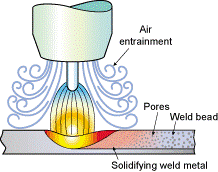The characteristic features and principal causes of porosity imperfections are described. Best practice guidelines are given so welders ca...
The characteristic features and principal causes of porosity imperfections are described. Best practice guidelines are given so welders can minimise porosity risk during fabrication.
Identification

Porosity is the presence of cavities in the weld metal caused by the freezing in of gas released from the weld pool as it solidifies. The porosity can take several forms:
Cause and prevention
Distributed porosity and surface pores
Cause
Porosity is caused by the absorption of nitrogen, oxygen and hydrogen in the molten weld pool which is then released on solidification to become trapped in the weld metal. Nitrogen and oxygen absorption in the weld pool usually originates from poor gas shielding. As little as 1% air entrainment in the shielding gas will cause distributed porosity and greater than 1.5% results in gross surface breaking pores. Leaks in the gas line, too high a gas flow rate, draughts and excessive turbulence in the weld pool are frequent causes of porosity.
 |
| Fig. 2 Surface breaking pores (T fillet weld in primed plate) |
Hydrogen can originate from a number of sources including moisture from inadequately dried electrodes, fluxes or the workpiece surface. Grease and oil on the surface of the workpiece or filler wire are also common sources of hydrogen.
Surface coatings like primer paints and surface treatments such as zinc coatings may generate copious amounts of fume during welding. The risk of trapping the evolved gas will be greater in T joints than butt joints especially when fillet welding on both sides (see Fig 2). Special mention should be made of the so-called weldable (low zinc) primers. It should not be necessary to remove the primers but if the primer thickness exceeds the manufacturer's recommendation, porosity is likely to result especially when using welding processes other than MMA.
Air entrainment
- seal any air leak
- avoid weld pool turbulence
- use a filler with the adequate level of deoxidants
- reduce the excessively high gas flow
- avoid draughts
Hydrogen
- dry the electrode and flux
- clean and degrease the workpiece surface
Surface coatings
- clean the joint edges immediately before welding
- check that the weldable primer is below the recommended maximum thickness
Prevention
The gas source should be identified and removed as follows:Air entrainment
- seal any air leak
- avoid weld pool turbulence
- use a filler with the adequate level of deoxidants
- reduce the excessively high gas flow
- avoid draughts
Hydrogen
- dry the electrode and flux
- clean and degrease the workpiece surface
Surface coatings
- clean the joint edges immediately before welding
- check that the weldable primer is below the recommended maximum thickness

No comments